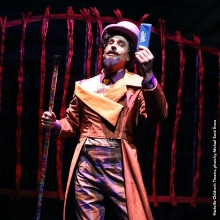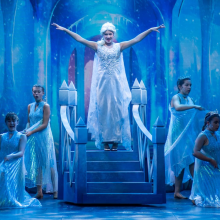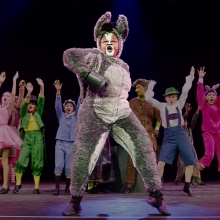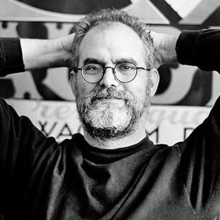Sergei Rachmaninoff
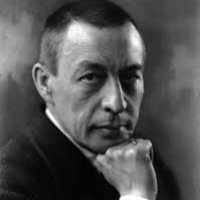
Sergei Vasilievich Rachmaninoff, also Sergey Rachmaninov or Serge Rakhmaninov (Серге́й Васи́льевич Рахма́нинов), (April 1, 1873 March 28, 1943) was a Russian composer, pianist, and conductor.
Born in Semyonovo, near Novgorod into a wealthy family with a strong military background, Rachmaninoff had his first piano lessons with his mother at the family estate at Oneg. After a decline in their fortunes, the family moved to Saint Petersburg where Rachmaninoff studied at the conservatory, before going on to Moscow, where he studied piano with Nikolay Zverev and Alexander Siloti (a student of Franz Liszt and Rachmaninoff's cousin). He also studied harmony with Anton Arensky and counterpoint with Sergei Taneyev. While still a student he wrote a one act opera Aleko, and a set of piano pieces, Op. 3, which contains the popular and famous PREDLUDE IN C SHARP MINOR, a piece he came to detest through 40 years of audiences demanding it as an encore at his piano recitals. Already in his early years he showed great composing skills. His first serious pieces for the piano were composed and performed when he was thirteen years old during his stay as student at Zverev's. In 1892, at an age of 19, he completed his first piano concerto. The Concerto was later revised in 1917.
Rachmaninoff's First Symphony was premiered in 1897, but was a complete flop with the critics. Some have suggested that this was largely due to the conducting of Alexander Glazunov, who disliked the piece and under-rehearsed it. Rachmaninoff's wife later suggested that Glazunov may have been drunk. This disastrous reception, coupled with his distress over the Orthodox church's objection to his marrying a cousin, Natalia Satina, led to a nervous breakdown. He wrote little music until he began a course of autosuggestive therapy with psychologist Nikolai Dahl. Rachmaninoff quickly recovered his confidence; one result of these sessions was the PIANO CONCERTO No. 2, written 1900/1901, which Rachmaninoff dedicated to Dr. Dahl. The piece was very well received at its premiere, at which Rachmaninoff played the solo part himself, and remains one of his most popular compositions, gaining fame from its use in the films BRIEF ENCOUNTER and THE SEVEN YEAR ITCH as well as having its themes made into popular songs in the 1940s. Rachmaninoff's spirits were further bolstered when, after years of engagement, he was finally allowed to marry Natalia. They were married by an army priest in 1902; their happy union lasted until the composer's death. Due to several successful appearances as a conductor, Rachmaninoff was offered a job as conductor at the Bolsjoj theatre in 1904. Political reasons lead to his resignment two years later. In 1908 he moved to Italy and later to Dresden while waiting for the situation in Russia to normalize.
THE SECOND PIANO CONCERTO secured Rachmaninoff's reputation as a composer, but he was also a very well known and highly respected pianist. His technical perfection and rhythmic drive were legendary and his large hands were able to cover a twelfth. He made many of recordings of his own music as well as the standard repertoire.
Rachmaninoff made his first recordings for Edison Records on their "Diamond Disc" records, as at the time the Edison company had the best audio fidelity in recording the piano. Rachmaninoff did not consider himself a great pianist, and thought his own performances variable in quality. He therefore asked that only his recorded performances that he personally approved be commercially issued. The Edison Company, possibly through simple carelessness, issued multiple alternative takes of Rachmaninoff's recordings (as was common in the gramophone record industry at the time for reasons of ease of mass production of records from multiple masters). Rachmaninoff was angered, left Edison, and thereafter recorded for the Victor Talking Machine Company (and later its successor, RCA Victor), which was pleased to abide by Rachmaninoff's restrictions and proudly advertised him as one of the great artists who recorded for the Victor Company. Rachmaninoff also made a number of piano rolls. Initially disbelieving that a roll of punched paper could provide an accurate record, he was invited to listen to a master roll of his first recording in 1919 for the Ampico company. He is then quoted as saying "Gentleman - I, Sergei Rachmaninoff, have just heard myself play!". He continued to record for Ampico until around 1929.
It was as a pianist that Rachmaninoff made his first tour of the United States in 1909, an event for which he wrote his PIANO CONCERTO No. 3. This successful tour made him very popular in America, and he emigrated to New York following the Russian Revolution of 1917. His compositional output then started to slow down to some degree, partly because he was required to spend much of his time performing in order to support himself, but the main cause was homesickness. When he left Russia, it was as if he had left behind his inspiration. Nevertheless, his RHAPSODY ON A THEME OF PAGANINI, one of his best known works, was written in the United States in 1934.
Rachmaninoff went on to write his SYMPHONY No. 3 (1935-36) and the SYMPHONIC DANCES (1940), his last completed work. He fell ill during a concert tour in the winter of 1943. Always a heavy smoker, he was diagnosed with lung cancer. Prophetically, his last recital, given in February 1943, featured Chopin's B FLAT MINOR SONATA - which includes the famous funeral march. He died on March 28, 1943 in Beverly Hills, California, having completed four piano concertos, three symphonies, two piano sonatas, the choral symphony THE BELLS (based on the poem by Edgar Allan Poe), a setting of the vespers and many songs, amongst other works. Most of his pieces are in a quite traditional romantic style, rather akin to Tchaikovsky, although a few of his later works, such as the FOURTH PIANO CONCERTO and THE VARIATIONS ON A THEME OF CORELLI are in a more emotionally detached style, which has made them rather less popular with audiences.
Sergei Rachmaninoff is interred in Kensico Cemetery in Valhalla, New York.
His first three piano concertos are among the greatest in the literature - often considered "definitive" interpretations are those by Vladimir Horowitz, close friend of Rachmaninoff, and Byron Janis, student of Horowitz; as well as extant records by Rachmaninoff himself.
Works, by Opus number
" (1891) Piano Concerto No. 1 op. 1
" (1892) Prelude & Oriental Dance op. 2
" (1892) Morceaux de Fantaisies op. 3 (includes "Prelude in C sharp minor")
" (1890) Six Songs op. 4
" (1893) Suite No. 1, op. 5, for two pianos
" (1893) Romance and Hunagrian Dance op. 6
" (1893) The Rock op. 7
" (1893) Trio Elegiaque, op. 9
" (1896) Symphony No. 1, op. 13
" (1896) Twelve Songs op. 14
" (1895) Six Choruses op. 15
" (1896) Six Moments Musicaux op. 16
" (1901) Suite No. 2, op. 17
" (1901) Piano Concerto No. 2 op. 18
" (1902) Twelve Songs op. 21
" (1903) Variations on a Theme of Chopin op.22
" (1903) Ten Preludes op. 23
" (1904) The Miserly Knight op. 24 (opera)
" (1905) Francesca da Rimini op. 25 (opera)
" (1906) Fifteen Songs op. 26, includes "Before My Window"
" (1908) Symphony No. 2 op. 27
" (1908) Sonata for piano No. 1, op. 28
" (1909) The Isle of the Dead op. 29 symphonic poem
" (1909) Piano Concerto No. 3, op. 30
" (1910) Liturgy of St John Chrysostom op. 31
" (1910) Thirteen Preludes op. 32
" (1911) Etudes-Tableaux op. 33
" (1912) Fourteen Songs op. 34
" (1913) The Bells op. 35
" (1913) Sonata for piano No. 2, op. 36
" (1915) All-Night Vigil op. 37
" (1916) Six Songs op. 38
" (1916) Etudes-Tableaux Opus 39
